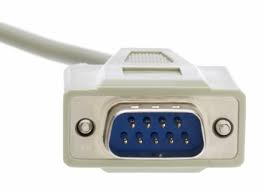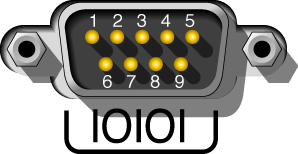What is a Serial Port?A serial port on a computer is an asynchronous port that connects a serial device to the computer and allows the computer to transfer or receive data one bit at a time. It is a type of connection on PCs, which is one of the oldest types of interfaces. It is commonly used to connect peripherals such as game controllers and mice to a computer, and it was once used to connect printers and external modems. For instance, a modem might connect to communication port 1 and a mouse to communication port 2. Modern serial ports are used in industrial machinery systems and scientific instruments and are usually found on IBM-compatible computers as COM (communications) ports. The below picture is an example of a DB9 serial connector on a cable. 
Sometimes it is also known as RS-232 port or COM port, and its data transfer rate is slower as compared to a parallel port. There are two kinds of serial ports: DB25 and DB9, where DB25 is a 25-pin connection, and DB9 is a 9-pin connection. A serial port is a male port that can only send one bit of data at a time, whereas a parallel port is a female port that can send several bits at the same time. Serial ports have been replaced in the newer computer by much faster and more compatible USB ports. System resource configurations are identified by COM1, COM2, COM3, COM4, and more; each COM position characterizes an interrupt request (IRQ) address as sell as an input/output (I/O). The RS-232, a serial port standard, is used to transmit serial communication between devices, commonly called DTE (data terminal equipment) and DCE (data terminal equipment). The standard utilised 25 pins since many of the connectors were large and underused, and the smaller DE-9 connector became popular. Higher speed communication, such as external data storage units, was required for serial communication. The faster interfaces were introduced by the FireWire and the Universal Serial Bus (USB). This new technology, known as the daisy chain that could have the ability to transfer data at high rates on the same bus. In modern times, the use of a serial port is even less common. It's rarely utilised, however it's used in flat-screen monitors, LCD displays, GPS receivers, LED displays, and bar-code scanners as a communication device. Identifying a serial portYou can see the DB9 serial port in the above image, which is immediately identifiable. The connection is in the shape of the letter D and has 9 pins and a male connector. Uses of serial portA list is given below that contains numerous hardware components, you can purchase them and use with serial port.
Serial port pin information
A list is given below that contains all the pins on the DB9 connector, including their purpose as well as signal name. The serial port is labeled as "10101" with various computers; these numbers are in zeros and ones that represent binary. The number "1" may also be interpreted as the letter "I" by the user and the zeros as the letter "O", which may be known as the "IOIOI" port.
Serial Ports are OutdatedIn the early 2000s, when the use of USB and wireless connections began, the use of serial ports was phased out. As compared to serial, USB was less complicated, easier to use, and much faster. In modern times, it can be difficult to find a computer system that includes the older serial ports, which are needed by the input or other peripheral devices. Standards for Serial PortsHistorically, the RS-232 has been the popular standard for traditional serial port communications. PC keyboards and other computer peripheral devices used these serial ports and cables for the same purpose. Generally, serial ports and cables have 9-pin DE-9 connectors for RS-232 PCs. However, 25-pin DB-25 and other variations exist on specialized hardware. Many Macintosh computers contain another standard RS-422. In favor of USB or FireWire communication, the RS-422 and RS-232 are now obsolete. How Serial Ports WorkThe serial port, which has been an intrinsic feature of most computers for more than 20 years and is regarded the most fundamental external connection to a computer, is an interface used to connect a serial device to the computer. The serial port is still used by most modern computers that connect to printers, PDAs, and digital cameras; nevertheless, the serial port is becoming outdated in many newer systems. And, more than two serial ports are available in a few computers. The serial port transmits the 8 bits in the byte one at a time, and it serializes" data; hence, its name "serial" comes from this fact. It has the advantage that only one wire is required to transmit the 8 bits. It also has the disadvantage of taking 8 times longer to send data if it has 8 wires. Furthermore, serial ports make cables smaller as well as lower cable costs. Before each byte of data, a serial port sends a start bit, which is a single bit with the value 0. It transmits a stop bit after each byte of data to indicate that the byte is complete. Serial ports are bi-directional communication that allows each device to transmit data and receive data as well. It is also known as communication (COM) ports. If the devices use the same pins, they could travel the information only in one direction at a time because it would limit communication to half-duplex. Therefore, serial devices use different pins to allow each device to transmit data as well as receive it because using different pins makes communication full-duplex that can travel information in both directions at once. The Universal Asynchronous Receiver/Transmitter (UART) is a controller chip on which the serial ports are dependent on functioning properly. The UART chip transforms the parallel output taken by the computer's system bus into serial form for transmission with the help of a serial port. In order to function quickly, most UART chips feature a built-in buffer of 16 to 64 kilobytes. Although this buffer processing data goes out to the serial port, it allows the chip to cache data that comes from the system bus. The Enhanced Serial Port and the Super Enhanced Serial Port are two sophisticated serial ports that can transport data at 460 kilobits per second. Most typical serial ports, on the other hand, have a data transfer rate of 115 Kbps.
Next TopicWhat is Google
|
 For Videos Join Our Youtube Channel: Join Now
For Videos Join Our Youtube Channel: Join Now
Feedback
- Send your Feedback to [email protected]
Help Others, Please Share










